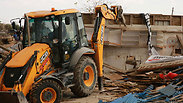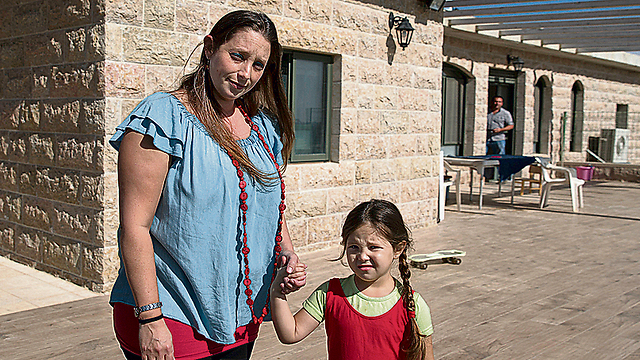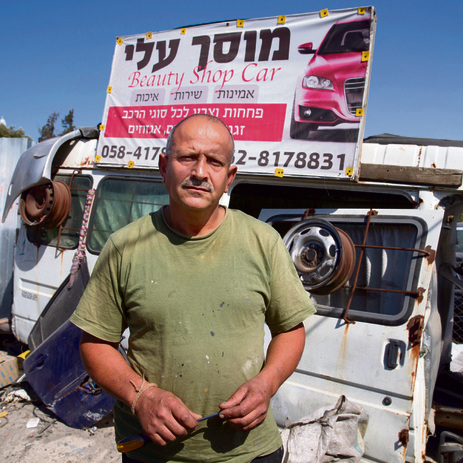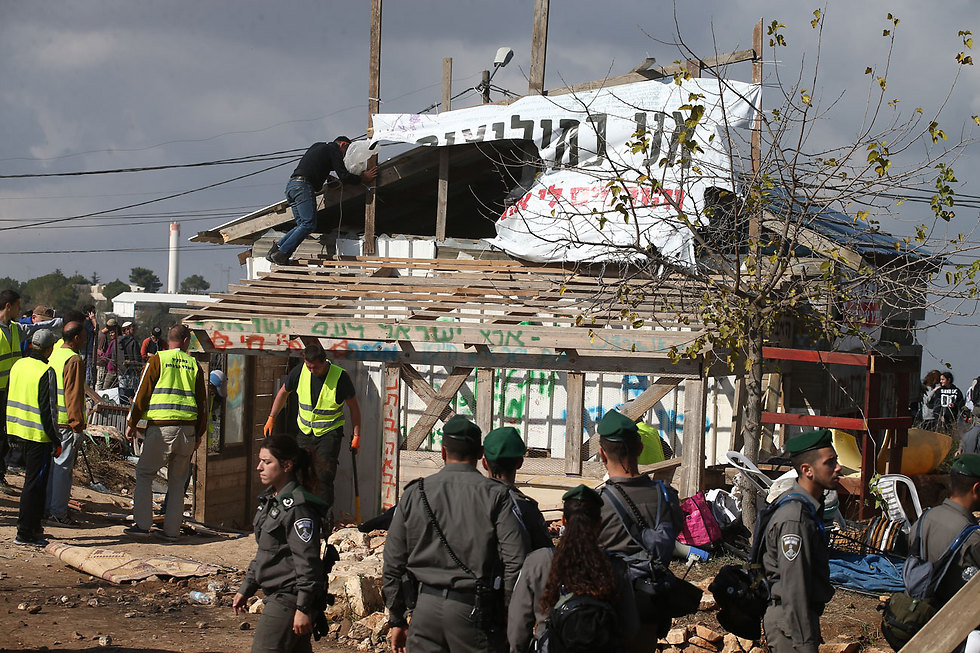

‘Had we known it was private land, we wouldn’t have built on it’
Almost every home in the top row of houses in Netiv Ha'avot includes illegal ‘extensions’ built on disputed land, leading the High Court to order the demolition of 15 of the outpost’s houses by March 2018; while residents say they settled on empty land, Ali Mousa from the nearby village won’t forget the day he saw caravans on a plot he inherited from his grandfather and ended up with a gun pointed at his head.
The home owner, Yael Dan Heijer, points to her house, which is marked on the map, and to another tiny dot, unmarked and almost invisible, at the southwestern part of the house. Almost every home in the top row of houses in the outpost is dotted by those small dots—illegal "extensions" added to the structures, built on disputed land.
The Dan Heijer family, for example, has a cranny in the children's bedroom, 1.5x3 meters in size, from four-year-old Tzlil's bed to the fitted wardrobe, which according to the map is on disputed land.

In the house of the next-door neighbors, the Bulviks, the hall and the dining area are on disputed land, while the rest of the home is on declared state land.
We went to every home on the top row of houses, where each family showed us its own "extension."
There are 42 homes in Netiv Ha'avot, which was built in 2001 as a neighborhood of the Elazar settlement. A High Court of Justice ruling from September 2016 determined 17 structures in the settlement must be demolished. Two of them—a monument in memory of Lt. Col. Emmanuel Moreno and Lt. Ezra Asher and a carpentry shop—have already been demolished. The monument was dismantled and erected anew 20 meters away from its original spot.
Of the 15 remaining homes set for demolition, the illegal extensions of six homes only make up a small part of the house. The owners of those six homes petitioned the High Court, asking to only remove the part built on disputed land rather than demolish the entire house. But in October, the court ruled against the six families, ordering them to demolish their homes entirely.
Former Chief Justice Miriam Naor, who headed the panel, stated that “in the case at hand, we did not distinguish between structures and parts of structures, due to their extension to disputed lands and due to other reasons, including the importance of maintaining the rule of law and upholding the state’s commitments to the court.”
The decision put a lid on the residents’ hope to avoid the harsh verdict. “Thanks to the court, we learned there is only one division which is relevant to us: The division between truth and falsehood,” Gush Etzion Council head Shlomo Ne’eman said following the ruling. “Between the truth in our right to follow our forefathers’ path to the falsehood of the cold law that is alienated from this fundamental right.”
Now, the clock is ticking in each and every one of these homes ahead of March 6, 2018, the deadline set by the court.
The story of Netiv Ha’avot isn’t essentially different from the stories of Amona and Migron. The residents did the exact same thing that has become a method in other outposts: Settling on the land without inquiring who it belongs to, placing caravans, receiving budgets from government ministries to build infrastrcture and building permanent homes illegally, without the required permits and approvals. Meanwhile, the Civil Administration issues stop-work orders and demolition orders, but doesn’t go to the trouble of enforcing them.
This situation is being used by Knesset members and ministers to issue statements and make promises that are eventually shattered by bulldozers. The Palestinian petitioners, who claim to own the land and hope to get it back, are caught in the middle. This is a case of false hope: The Migron homes were demolished more than five years ago, the residents were evacuated, but the land remains empty and hasn’t been handed over to a single Palestinian. The exact same thing happened in Amona, as well as in the nine homes demolished in Ofra, and the same will likely happen in Netiv Ha’avot too.
Popsicles instead of figs
Each side has its own starting point. For the settlers, the second intifada brought shooting attacks, stone-throwing and the hurling of Molotov cocktails on Highway 60 on an almost daily basis. Matan Yehezkeli, a local resident, says the Palestinians also tried to create a settlement sequence between the villages of Husan and Battir, west of Gush Etzion, to Bethlehem on its eastern side.
“That’s how this hill was selected,” Yehezkeli says. “It both overlooks Highway 60 and disrupts the Palestinian sequence. The Gush Etzion Regional Council was part of the initiative pushed by the residents of Elazar. At first, the place was settled by 10 families, who didn't place caravans wherever they wanted, but based a Civil Administration map. Not a single tree was uprooted to place the caravans. We didn’t touch the farmland.”
His neighbor, Rachel Bulvik, says the agricultural plots that were cultivated by Palestinians near the outposts’ homes are still being cultivated by them. “They harvest and pick. We see them working from the windows of our houses. We have no problem with that,” she says.
“They’ve asked me for water several times,” says Yael Dan Heijer. “The kids offered them popsicles.”

Ali Mousa, who owns a garage located on the road leading to settlement of Efrat, has a slightly different version of course. Mousa, 51, was born and lives in the village of al-Khader in the Bethlehem area.
“What they call Netiv Ha’avot is Jabel Habun to us,” he says. “I own land there in Plot 77. My grandfather had 70 dunams (17 acres) there, and I got 13.5 dunams of that. My land was planted with grapes, almonds and figs. It’s part of our culture. Eating from the figs and grapes I was growing was enough for me.
“In late 2000, on a winter day, I rode my mule there through a trail on the land. Suddenly, I saw caravans on my land and on plots belonging to my uncles and neighbors from the village. I started shouting, ‘Who gave you permission?’ I went wild with anger. There were solar water heating panels on the ground, and I broke them.
“Suddenly, two guys showed up, one of them carrying a weapon. He directed his rifle at me and shouted, ‘Stop running wild, or I’ll shoot you.’ The other one kneed me in the stomach several times, pushed me down and bound my hands with a cable tie. A military jeep arrived, and they threw me in the back. The soldiers sitting there put their feet on me. They dropped me off at the Elazar gate and told me to wait for the police to arrive.
“Meanwhile, the settlement’s guards watched me. One of them pointed his weapon at me and said to his friends, ‘I’m going to shoot him in the knee.’ Another guard said, ‘Why in the knee? Shoot him in the head.’ I thought my end was near. I was so scared I nearly peed my pants.”
Do you have any crops left in the groves there?
“Only those whose land is slightly far from the Jews’ homes are allowed to approach that area. I tried to reach my land several times, but I was driven away by people carrying weapons.”
The incident developed into a long legal battle, which ended in a High Court ruling in September 2016, ordering the demolition of 17 homes in the outpost. The legal battle was waged by attorneys Michael Sfard and Shlomi Zacharia on behalf of Peace Now.
That didn’t stop the settlers from building more permanent homes there, despite the stop-work orders and demolition orders, adding one house after another.
Ze'ev ('Zambish') Hever, CEO of Amana, the Yesha Council’s settlement branch, joined the hill too. At first, he lived in a caravan like his neighbors, while building a stone house, which he moved into about three years ago.
Escaping demolition
While the legal battle was being fought, the state attempted to find a solution that would prevent the demolition. A survey was conducted on the outpost’s lands, and in 2014 some of them were declared state lands. As a result, most of the homes escaped demolition, including Zambish’s house, and some parts of the other houses became “illegal extensions.”
Mousa, his relatives and his neighbors petitioned the Civil Administration against turning some of the plots into state lands. The matter is still under discussion.
Yehezkeli says that used to be the method at the time he settled on the hill. “No one asked questions. Had we known it was private land, we wouldn’t have built on it, of course. We would have built next to it. And we built without a permit. Part of the ideology was to settle and create facts on the ground. It wouldn’t have been possible any other way.
“In court, we presented documents showing the state had taken part in the place’s establishment. We presented documents for the access road, the water pipes, the infrastructure development. These aren’t things we funded from our own pockets.”
“And when we started building,” his neighbor Talia Bar-Lev interrupts, “Civil Administration supervisors arrived with a stop-work order. My husband asked them what should he do with it, and they replied: ‘Our job is to hand you the order. You can hang it on your fridge.’ That’s the way things worked back then.”
Mousa says he kept working at his garage and fixing the cars of settlers living in the area while fighting his legal battle. About a year ago, however, after the hill’s residents found out that a demolition order had been issued against the garage and that it was operating without a business license, they called on Gush Etzion residents to boycott the person trying to remove them from their homes.
“It affected my work and my children’s livelihood,” Mousa says. “Look, it’s noon and I’m sitting here with you. All I have is one car of a guy from Tekoa, one car to prepare for inspection and an exhaust welding. Some days, there’s no work at all.
“I spoke to a rabbi in Efrat, who said he would try to do something. He said it was wrong to boycott me, but he didn’t say anything out loud. It feels really bad. They printed stickers reading, ‘Don’t help the destroyer of Netiv Ha’avot,’ and stuck them on cars. They robbed me of my land and took away my livelihood. I’ve been hit from every direction. Enough, leave something for me.”
Then, on the hill, when we asked the residents about the boycott against Mousa, they said they had no idea what we were talking about. “I’ve never taken my car to his garage,” Yehezkeli said.
‘All we have is a piece of paper’
Now, the residents are working the political angle to try to find a solution that would keep them on the hill.
“We plan to promote a bill in the Knesset’s winter session allowing the state to delay the implementation of High Court rulings by several years in certain cases,” Yehezkeli reveals. “The ruling would only be implemented after the families are offered a normal solution.”
They met twice with Prime Minister Benjamin Netanyahu, who instructed his chief of staff Yoav Horowitz to come up with a solution to the problem. That’s how the move to Plot 91, in the eastern part of Elazar, came about.
“When we sat with Netanyahu, he said to Horowitz: ‘Build them permanent homes there, not caravans like in Migron,’” Yehezkeli recalls.
That was last August. Recently, the residents found out that Plot 91 would be filled with caravans and that their accommodation there would be defined as temporary for just three years, until the approval of a neighborhood with permanent homes.
“Our concern is that the temporary will become permanent,” says Dan Heijer. “We don’t want to turn into a second Migron.”
We telephoned Zvi Gilo, who was evacuated from the outpost of Migron about five years ago. Gilo and the rest of the evacuated families are still living in a caravan site despite being promised the caravans would only be a temporary two-year solution.
“On the eve of the evacuation, the government made a decision to establish a permanent community at the bottom of Reches Migron (Migron Ridge) in Givat Hayekev (Winery Hill), where the caravan site is located now. A temporary urban building plan was issued for the site for two years. It was clear to us that we would begin a quick process to regulate the urban building plan for a permanent community.
“In practice, we have seen no progress since then, and the temporary urban building plan was extended by two more years with the defense minister’s signature. Those two years have also passed, and as far as I know, the temporary urban building plan hasn’t been renewed. Last week, the permanent community’s urban building plan was approved by the Civil Administration, but we can’t start building yet because it has to be approved by the prime minister. So in the meantime, all we have is a piece of paper.
“The people of Netiv Ha’avot will suffer the same fate. They have to be mentally prepared. They should know that what the politicians promise them is written on ice. They will have to fight for every stage in the new neighborhood’s approval. They will wear them out. They should know that they’re going to live in caravans for many years and should take a deep, deep breath.”
Gilo says the hill he was evacuated from has remained empty. “It’s 2 kilometers from my house, and sometimes I pass by and there’s nothing there. The court hasn’t ruled who the land belongs to yet.”
Shabtay Bendet, head of settlement watch at Peace Now, says justice isn’t fully served.
“The Palestinians fight for their lands, the High Court rules in their favor, but they’re not allowed to return to the lands. On the other hand, the state feels a need to find housing solutions for settlers who—as ruled by the court—built their homes on private land illegally. Nowhere else in this country would intruders and construction criminals be given a remedy.”


















